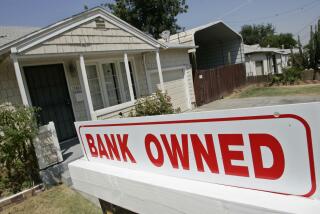Rx for our financial crisis
- Share via
Call it “a bailout in every pot”: Having poured money into storied Wall Street institutions and major banks, the federal government is considering more aid for homeowners who are defaulting on their mortgages, along with billions in loans to help two U.S. automakers merge their troubled operations. There’s also talk of another stimulus package of $150 billion or more.
FOR THE RECORD:
FDIC bailout: An Oct. 31 editorial said the FDIC had saved about two-thirds of IndyMac Bank’s defaulting borrowers from foreclosure. The FDIC’s program determined that about two-thirds of the borrowers could qualify for a rescue, but fewer than half of those qualified borrowers had responded to the FDIC’s offer. —
The ever-expanding roster of rescues is a testament to how stubborn the problems in the U.S. economy are. Providing $30 billion to save Bear Stearns Cos. from default in March didn’t prevent Lehman Bros. from going under six months later. Offering a bigger credit line to Fannie Mae and Freddie Mac in July didn’t avert a complete government takeover in September. And so it has gone, on down the list of interventions.
Lost amid the scattershot responses is the rationale for government’s deepening role in the economy: a breakdown in the financial markets. The hands-off approach to enforcing bank and lending rules, combined with an overly long period of ultra-low interest rates, created the perverse incentives that swelled property values and propelled risk-taking. When those values started to fall, the results were just as irrational in reverse. Market forces couldn’t sort out the mess without causing even more widespread damage to the economy. But Washington didn’t know how to fix things either.
So here we are, looking at another series of moves that might work. Or not. The most promising is an initiative promoted by FDIC Chairwoman Sheila Bair to stave off more foreclosures by offering federal guarantees to lenders that refinance defaulting mortgages. Similar plans have been approved by Congress (in a measure to increase oversight of Fannie and Freddie) and by several state attorneys general (to settle lawsuits on behalf of Countrywide mortgage holders). The FDIC is taking such steps already on the troubled mortgages held by IndyMac Bank, which the feds seized in July. Through this program, the FDIC has saved about two-thirds of the defaulting borrowers from foreclosure by temporarily cutting interest rates and monthly payments to a standard level of affordability (38% of the borrower’s monthly income).
The idea of helping homeowners in financial trouble isn’t a popular one, to put it mildly. But it gets at the heart of the crisis in the financial markets, which is closely related to the problems in the larger economy. According to a new study by researchers at USC and UCLA, the slide in home values is likely to constrict spending by consumers significantly, making it harder for the economy to rebound. Such aid also is consistent with the principle of intervening when the market can’t help itself. Despite the banking industry’s voluntary efforts to help borrowers, statistics compiled by the industry show that the number of loan modifications only recently has caught up to the number of borrowers starting the foreclosure process. And in the last three months, the number of prime loans -- issued to less-risky borrowers -- going into default has surpassed the number of subprime ones going bad. Those are two good reasons to keep intervening.
More to Read
A cure for the common opinion
Get thought-provoking perspectives with our weekly newsletter.
You may occasionally receive promotional content from the Los Angeles Times.








